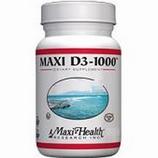
 Regular Retail: $6.99
Regular Retail: $6.99Very few foods in nature contain vitamin D. Obtaining sufficient vitamin D from natural food sources alone can be difficult. For many people, consuming vitamin D-fortified foods and being exposed to sunlight are essential for maintaining a healthy vitamin D status. In some groups, dietary supplements might be required to meet the daily need for vitamin D.
Americans aged 50 and older are at increased risk of developing vitamin D insufficiency. As people age, skin cannot synthesize vitamin D as efficiently and the kidney is less able to convert vitamin D to its active hormone form. As many as half of older adults in the United States with hip fractures could have serum 25(OH)D levels <12 ng/mL (<30 nmol/L). Therefore they would need vitamin D supplementation.
Home bound individuals, people living in northern latitudes (such as New England and Alaska), women who wear long robes and head coverings for religious reasons, and people with occupations that prevent sun exposure are unlikely to obtain adequate vitamin D from sunlight.
More than 25 million adults in the United States have or are at risk of developing osteoporosis, a disease characterized by fragile bones that significantly increases the risk of bone fractures. Osteoporosis is most often associated with inadequate calcium intakes (generally <1,000-1,200 mg/day), but insufficient vitamin D contributes to osteoporosis by reducing calcium absorption. Osteoporosis is an example of a long-term effect of calcium and vitamin D insufficiency. Adequate storage levels of vitamin D maintain bone strength and might help prevent osteoporosis in older adults, nonambulatory individuals who have difficulty exercising, postmenopausal women, and individuals on chronic steroid therapy.
Most supplementation trials of the effects of vitamin D on bone health also include calcium, so it is not possible to isolate the effects of each nutrient. The authors of a recent evidence-based review of research concluded that supplements of both vitamin D3 and calcium decreased the risk of falls, fractures, and bone loss in elderly individuals aged 62-85 years. The decreased risk of fractures occurred primarily in elderly women aged 85 years, on average, and living in a nursing home. Women should consult their health care providers about their needs for vitamin D (and calcium) as part of an overall plan to prevent or treat osteoporosis. Recent studies show, that taking 2000 IU or more is safe and is highly recommended.
Other Ingredients: Microcrystalline, cellulose, vegetable stearine, Enzymax® (calcium carbonate, bromelain, papain, lipase, amylase, protease, silica) magnesium stearate, modified cellulose gum and vegetable protien.
Food Sensitivity: This product contains no animal products, wheat, salt, sugar, milk, yeast, artificial flavors, colorings or preservatives.
Note:
Product image may vary in look, size, quantity and/or flavor. It should only be used as a reference. Please check with the manufacturer for the most up-to-date product information.
Although we try very hard to keep the product information up-to-date, occasionally, the manufacturer changes the name and the packaging of a product without notice.
Share your thought and comments. Be the first to write a review.